Preliminary report on the 2015 breeding season
The primary aim of BTO surveys is to monitor changes in the health of Britain’s birds, tracking declines and increases via the BTO/JNCC/RSPB Breeding Bird Survey and exploring the factors driving them through bird ringing and nest recording. The long-term trends in abundance, survival and breeding success generated by these schemes are presented on the BirdTrends webpages.
This report provides a preliminary assessment of the 2017 breeding season in terms of population sizes and breeding success, comparing this year’s results to the averages recorded over the previous five seasons.
How do we monitor the breeding season?
giving a more complete picture of the season.
All of the data presented here are collected by BTO volunteers and we are extremely grateful for their efforts. Numbers of adult birds are monitored by qualified bird ringers running a network of approximately 140 Constant Effort Sites (CES) across Britain & Ireland between May and August. As their effort is standardised annually, the number of birds caught in each year provides an accurate measure of changes in abundance. Recaptures of birds ringed in previous years also allow survival rates to be calculated. The timing of nesting and the number of fledglings reared during each breeding attempt is monitored by over 700 participants in the Nest Record Scheme (NRS), who locate nests and count the eggs and young inside at regular intervals. The ratio of juvenile to adult birds caught on CES sites provides a second measure of breeding success that also takes into account the number of successful breeding attempts made per adult (as many species attempt to rear more than one brood per season) and the survival of young birds after fledging.
CES covers 24 woodland, scrub and reedbed species, while NRS covers 150 species breeding across all habitats, from gardens to remote hillsides. Returns from both surveys are still arriving at the BTO, so the figures presented here are representative of a subset of sites and species for which we currently have sufficient data to analyse.
What was the weather like in 2015?
Compared to the stormy winter experienced in 2014, the early part of 2015 was relatively benign. It was the sunniest winter since 1929, with near average temperatures across the board (Figure 1a); Northern Ireland was the coldest part of the UK. Most of the country remained relatively dry until May, when unsettled, cool conditions resulted in conditions that were much wetter than average. Northern parts of Britain experienced the highest rainfall totals, with Scotland recording is sixth-wettest winter since 1910 (Figure 1b). Summer 2015 was cooler and wetter than the previous two summers. June was predominantly dry and calm, particularly in the south, but July and August again saw unsettled weather with spells of heavy rain.
Poor year for long-distance migrants
CES results indicate that 2015 was a mixed year for migrant species. Short-distance migrants Chiffchaff and Blackcap, which typically winter around the Mediterranean basin and into North Africa, demonstrated statistically significant increases in abundance in 2015 compared to the five-year mean (2010-14) (Table 1). Data show that both species fared well over the winter months, with Blackcap experiencing the highest survival rates since CES began in 1983; Blackcap numbers may also have been boosted by an extremely productive 2014 season which saw very large numbers of young birds produced. Increases in Blackcap abundance were broadly similar across the UK, but Chiffchaff numbers increased more markedly in the north of England and Scotland.
Despite a generally productive breeding season in 2014, long-distance migrants, defined as those that winter south of the Sahara, fared less well in 2015, with both Willow Warbler and Whitethroat exhibiting their worst year for abundance since CES records began in 1983. Previous analyses have shown that growing season droughts in the Sahel region of Africa can have strong negative consequences for sub-Saharan migrants, decreasing food availability on passage, and figures from the period July-October 2014 indicate that rainfall totals were indeed below average over this period. However, the fact that declines showed strong regional variation, with abundance in the east less significantly affected than in the north or west, suggests that weather on the breeding grounds also influenced numbers. Sedge and Reed Warbler also fared better in the east, but significant increases there were cancelled out by declines in other parts of Britain.
Table 1. Adult abundance and breeding success calculated from 2015 CES data. Figures represent a percentage change relative to the five-year average (2010-14), with lower and upper 95% Confidence Intervals given in brackets. Statistically significant (p < 0.05) positive and negative changes are highlighted in blue and red respectively. '*' denotes a small sample size.
|
Species |
Adult abundance change (%) |
Productivity change (%) |
||
|
Migrant warblers |
||||
|
Chiffchaff |
16 |
(7, 26) |
-9 |
(-17, 0) |
|
Willow Warbler |
-14 |
(-21, -7) |
-26 |
(-34, -18) |
|
Blackcap |
16 |
(9, 23) |
5 |
(-3, 13) |
|
Garden Warbler |
-4 |
(-15, 9) |
-3 |
(-21, 18) |
|
Lesser Whitethroat* |
8 |
(-12, 31) |
-10 |
(-32, 20) |
|
Whitethroat |
-33 |
(-40, -26) |
24 |
(8, 41) |
|
Sedge Warbler |
3 |
(-4, 11) |
-32 |
(-39, -24) |
|
Reed Warbler |
-3 |
(-8, 2) |
14 |
(6, 23) |
|
Resident Tits |
||||
|
Blue Tit |
9 |
(1, 18) |
-10 |
(-19, -1) |
|
Great Tit |
16 |
(6, 27) |
-38 |
(-45, -30) |
|
Willow Tit* |
6 |
(-47, 111) |
-30 |
(-74, 85) |
|
Long-tailed Tit |
20 |
(8, 33) |
-8 |
(-20, 5) |
|
Other Residents |
||||
|
Cetti’s Warbler* |
38 |
(11, 72) |
15 |
(-16, 57) |
|
Treecreeper* |
11 |
(-15, 47) |
3 |
(-27, 46) |
|
Wren |
37 |
(26, 48) |
-8 |
(-16, 2) |
|
Blackbird |
2 |
(-5, 10) |
-26 |
(-35, -16) |
|
Song Thrush |
30 |
(16, 46) |
-20 |
(-35, -2) |
|
Robin |
37 |
(24, 51) |
-19 |
(-28, -9) |
|
Dunnock |
11 |
(2, 20) |
-14 |
(-24, -4) |
|
Chaffinch |
-12 |
(-21, -1) |
-31 |
(-42, -16) |
|
Greenfinch |
-23 |
(-36, -7) |
-25 |
(-44, 0) |
|
Goldfinch |
19 |
(2, 39) |
14 |
(-14, 51) |
|
Bullfinch |
14 |
(4, 25) |
-7 |
(-20, 8) |
|
Reed Bunting |
1 |
(-10, 13) |
-26 |
(-40, -9) |
Boost for residents
The average weather conditions in Britain & Ireland over winter 2014-15 boosted numbers of many residents. Wren and Cetti’s Warbler, both species known to be particularly sensitive to cold snaps, demonstrated significant increases in abundance, as did ground-feeders such as Song Thrush, Robin and Dunnock, which can fare poorly during winters with extensive snow cover. The latter group fared better in the west and north, possibly benefiting from the elevated rainfall in these areas, which increases the accessibility of soil invertebrates, at the start of the breeding season. Blue Tit, Song Thrush and Dunnock in particular experienced higher than average survival rates over the 2014-15 winter (Table 1). As with Blackcap, a high level of recruitment following last year’s bumper breeding season may also have contributed to the increase in numbers.
The main losers in 2015 were again Chaffinch and Greenfinch, both of which exhibited significant declines in abundance.
Trichomonosis
Conversely, more Goldfinches were captured on CE sites in 2015 than ever before and a significant increase in Bullfinch numbers was also recorded. Garden BirdWatch data show that in 2015 both Goldfinch, which is the subject of a new BTO survey, and Bullfinch numbers were higher than average in British gardens, whereas Chaffinch and (particularly) Greenfinch numbers were below average in 2015; neither Goldfinch nor Bullfinch has been as badly affected by trichomonosis.
Late start to the breeding season
The warm spring that gave rise to an early breeding season in 2014 wasn’t repeated in spring 2015. While temperatures were around the average, mean laying dates for a handful of residents, including the three tit and two wagtail species monitored plus Little Owl, were slightly later than in recent years (Table 2). It may be that the wet weather during March delayed breeding or that the heavy rainfall in May led to an increase in the number of failures and therefore of replacement clutches produced, shifting the average laying date later into the season.
Laying dates of migrants may also be influenced by the timing of arrival on the breeding grounds. However, while Chiffchaff, Blackcap, Pied Flycatcher and Redstart all displayed small but significant delays in laying in 2015, BirdTrack data do not suggest that any of these species were late to appear on the breeding grounds this season; the heavy rainfall in May therefore remains the most likely cause of later than average breeding phenology.
Woodpigeon, Barn Owl and Coot laying dates were significantly earlier than average, by 12, 18 and 10 days respectively. All these species have the potential to breed several times during each season but the stormy weather in August and September may have reduced the number of later breeding attempts, while the mid-summer crash in vole numbers and the resulting poor condition of adult birds may have reduced the number of Barn Owl pairs producing late broods. The apparent advance in Coot breeding is also likely to be a reduction in the number of nesting attempts made towards the end of the season, but the cause is unknown.
Table 2. Laying dates and breeding success calculated from 2015 NRS data. Laying dates are given as the number of days earlier or later than the five-year average (2010-14) while productivity figures represent a percentage change relative to the five-year average. Statistically significant (p < 0.05) positive and negative changes are highlighted in blue and red respectively. ‘*’ denotes small sample size (< 50 records).
|
Species |
Laying date days |
Clutch size % |
Brood size % |
Egg stage survival % |
Chick stage survival % |
Fledglings produced % |
|---|---|---|---|---|---|---|
Migrants |
||||||
| Sand Martin | 3.3 | -1.9 | -3.7 | -3.7 | 0.2 | -7.1 |
| Swallow | 0.8 | 0.4 | 0.9 | -1.6 | -3.2 | -3.9 |
| Chiffchaff | 4.0 | -0.2 | 1.9 | -22.0 | -14.7 | -32.2 |
| Willow Warbler | 2.7 | 1.1 | -2.6 | -11.5 | -5.4 | -18.5 |
| Blackcap | 5.3 | -1.6 | 3.0 | 0.3 | 3.1 | 6.5 |
| Reed Warbler | -1.9 | -1.7 | 0.8 | -8.6 | -1.6 | -9.4 |
| Spotted Flycatcher | 1.7 | -2.1 | 1.9 | -3.3 | -1.3 | -2.8 |
| Pied Flycatcher | 1.3 | 1.0 | 0.1 | -5.4 | -0.2 | -5.5 |
| Redstart | 3.0 | -4.1 | 0.9 | -9.1 | -9.3 | -16.8 |
Tits |
||||||
| Blue Tit | 2.0 | -6.8 | -9.8 | -1.9 | -2.7 | -13.9 |
| Great Tit | 3.4 | -8.8 | -11.4 | -1.0 | -3.8 | -15.6 |
| Long-tailed Tit | 2.7 | 0.0 | 10.8 | -11.2 | -3.0 | -4.6 |
Other resident passerines |
||||||
| Jackdaw | -0.7 | 4.1 | 3.7 | -3.7 | 8.8 | 8.7 |
| Nuthatch | -0.2 | 0.6 | 3.9 | -2.6 | -0.8 | 0.5 |
| Wren | -0.1 | -7.3 | 3.7 | 4.9 | 5.3 | 14.5 |
| Starling | -2.1 | -0.8 | 14.8 | 4.9 | -8.2 | 10.5 |
| Dipper | -0.4 | 2.3 | 5.2 | 6.2 | -3.9 | 7.4 |
| Blackbird | 0.2 | -2.5 | -0.7 | -10.9 | -15.1 | -24.9 |
| Song Thrush | 1.1 | -0.8 | -2.7 | 6.0 | 1.7 | 4.9 |
| Robin | 1.9 | 1.6 | 4.0 | -6.1 | -5.5 | -7.7 |
| Stonechat | -4.1 | -2.3 | -4.6 | -6.4 | 6.7 | -4.7 |
| Dunnock | 0.6 | 2.6 | 2.7 | -0.8 | -0.1 | 1.7 |
| House Sparrow | 4.2 | -2.0 | 6.2 | 0.3 | -7.1 | -1.1 |
| Tree Sparrow | -0.5 | -3.1 | -7.3 | -5.4 | -3.1 | -15.1 |
| Grey Wagtail | 6.9 | -1.9 | -2.9 | -7.1 | 6.6 | -3.8 |
| Pied Wagtail | 10.0 | -1.7 | -0.7 | -1.1 | -2.9 | -4.6 |
| Meadow Pipit | 3.7 | 3.6 | -1.6 | 5.8 | 11.8 | 16.3 |
| Chaffinch | 4.0 | -7.4 | -6.9 | 5.3 | -3.2 | -5.1 |
| Linnet | 0.7 | -1.8 | 1.9 | 3.0 | 13.4 | 19.1 |
Resident non-passerines |
||||||
| Stock Dove | -0.7 | 0.1 | 0.3 | -0.8 | 3.9 | 3.4 |
| Woodpigeon | -12.3 | -1.1 | -1.5 | -31.0 | -37.7 | -57.6 |
Owls and raptors |
||||||
| Barn Owl | -17.6 | -10.2 | -18.5 | 2.3 | -0.7 | -17.2 |
| Little Owl | 9.9* | -1.9 | -6.4 | 5.5* | 7.6 | 6.3 |
| Tawny Owl | 0.4* | 1.4 | -1.5 | -9.4 | 0.0 | -10.8 |
| Kestrel | 2.4* | -1.4 | -3.9 | 2.8 | 3.4 | 2.2 |
Waterbirds |
||||||
| Moorhen | -1.8 | 2.2 | 12.4* | -31.9 | -40.6* | -54.5* |
| Coot | -9.5 | -1.7 | -1.0 | -26.4 | -45.8* | -60.5 |
Poor breeding season for many…
b) Reed Warbler and c) Willow Warbler breeding success from 1983 to 2015,
calculated using CES data (2015 data points are shown in red).
In a complete reversal of fortunes from 2014, both the CES (Table 1) and NRS (Table 2) figures indicate that 2015 was a poor breeding season for most resident species. Blue Tit, Great Tit, Blackbird, Song Thrush, Robin, Dunnock, Chaffinch and Greenfinch all displayed significantly lower than average breeding success on CE sites. Blue Tit, Great Tit, Blackbird and Tree Sparrow also produced fewer fledglings per breeding attempt (FPBA) than the five-year average according to NRS data, with Blackbird FPBA was the lowest on record (Figure 3).
For the majority of species, the wet weather during May and July is likely to be primarily responsible for the lack of juveniles, respectively increasing failure rates at the nesting stage, as indicated by the above average egg failure rates exhibited by a wide range of species, and reducing the post-fledging survival rates of those offspring that did leave the nest successfully. Support for this hypothesis is strengthened by the fact that productivity declines identified by CES were particularly pronounced in the north, where conditions were wettest. There is some evidence to suggest that wet weather prior to the start of laying may also have had a negative impact on female condition as clutch sizes of Blue Tit, Great Tit, Wren, Blackbird, Tree Sparrow and Chaffinch were all significantly below average; Blue Tit clutch sizes were the lowest recorded since NRS trends began in the mid-1960s.
The story for migrants was slightly more complicated. The only species to demonstrate a significant increase in productivity on CE sites in 2015 were Whitethroat and Reed Warbler. As numbers of both of these species were reduced in 2015, it is possible that density dependence contributed to their breeding success in 2015, with competition between individuals decreasing as numbers fall. In addition, both are found in larger numbers towards the south of Britain, where the weather was generally more clement. In contrast, the worst hit migrants in 2015 were Willow Warbler, which recorded its lowest productivity on record, and Sedge Warbler, species with a more northerly distribution; Blackcap and Chiffchaff also experienced significant declines in breeding success in the north, but fared better elsewhere.
…including owls and raptors
After last year proved to be the most successful breeding season on record for owls and raptors, those who predict that crashes in vole numbers occur the season immediately after a peak vole abundance year appear to have been proven right. NRS data suggest that, of the owls and raptors, Barn Owl and Tawny Owl fared worst, perhaps unsurprisingly as these species are more reliant on small mammal prey than Little Owl and Kestrel, which also take a variety of invertebrates and birds. Barn Owl brood size was the second lowest recorded since the NRS trend was first calculated in 1966 (Figure 4). Furthermore, reports from fieldworkers indicate that a large proportion of birds suspended breeding altogether in 2015, so these figures underestimate the true drop in breeding success exhibited in the last 12 months.
Only in 1970 did Barn Owl produce smaller broods than in 2015.
...and Woodpigeon
Yet again, Woodpigeon appeared to be the biggest loser in 2015 with a near 60% decline in productivity, seemingly caused by poor survival at the egg stage. Although laying dates were earlier than normal in 2015, the cool, wet spells in July / August, the peak breeding time for Woodpigeon, could have been responsible for lowering egg survival rates. Although Woodpigeon has had two particularly bad breeding seasons, the CBC/BBS trend for this species shows a long-term and continuing increase in numbers since the mid-1970s.
Help us to monitor birds in 2016!
The records used to produce the NRS results are generated by over 700 NRS volunteers, who monitor nests ranging from Blue Tit boxes in gardens to seabird colonies on cliffs. If you haven't tried nest recording before, why not give it a go? Email us for a Quickstart Guide or visit the NRS web pages to find out more.
If you are a qualified ringer with access to an area of scrub, woodland or reedbed where there is the potential to catch at least 250 birds per season, why not register a CES? And if you aren’t able to start your own site, why not consider helping out at an existing one? Contact the CES Organiser for more information.
Acknowledgements
We are extremely grateful to all Constant Effort Site ringers and nest recorders for their monitoring efforts and for the support of the BTO/JNCC partnership, which the JNCC undertakes on behalf of the Country Agencies. Additional funding for the BTO Ringing Scheme is provided by The National Parks and Wildlife Service (Ireland) and the ringers themselves. The Breeding Bird Survey is run by the BTO and jointly funded by the BTO, the JNCC and the RSPB. BirdTrack is organised by the BTO for the BTO, RSPB, BirdWatch Ireland, SOC and WOS.

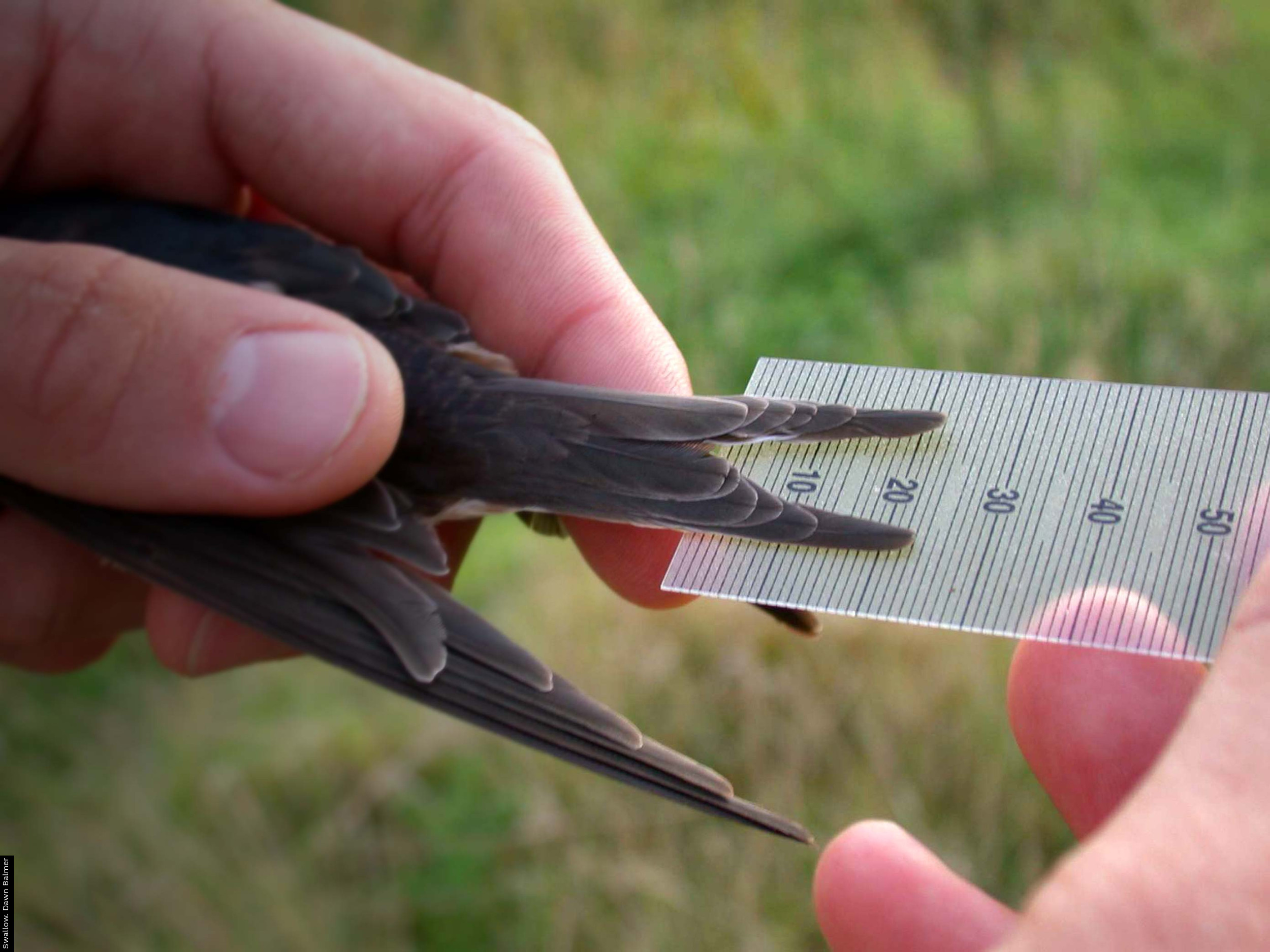
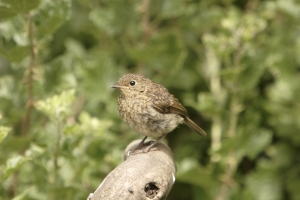

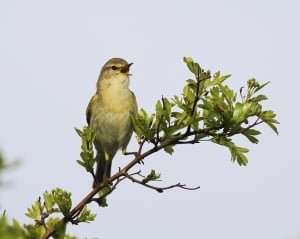
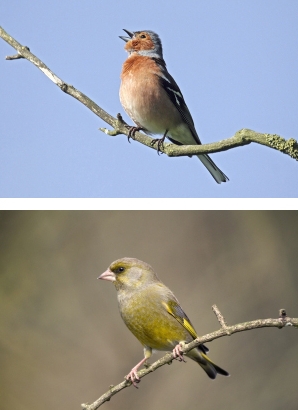

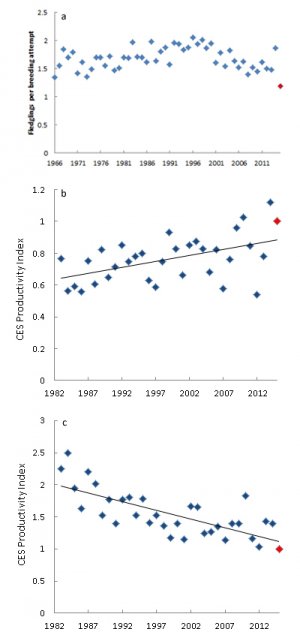






Share this page